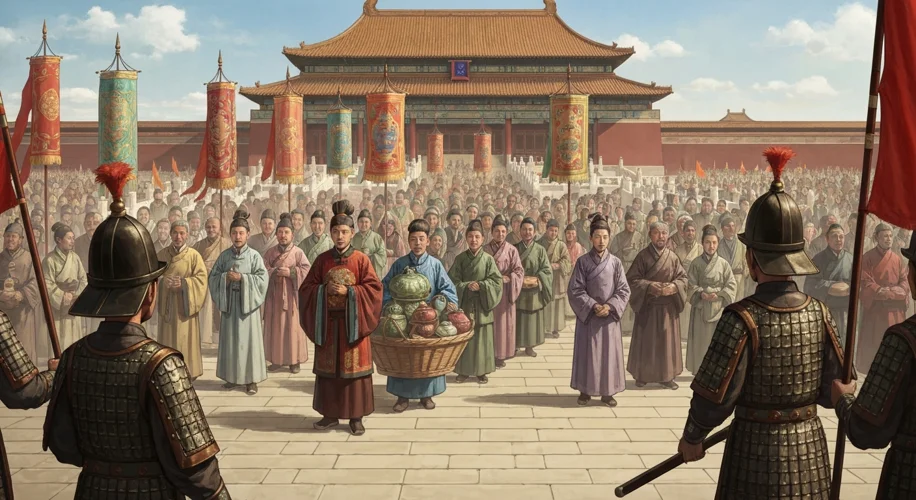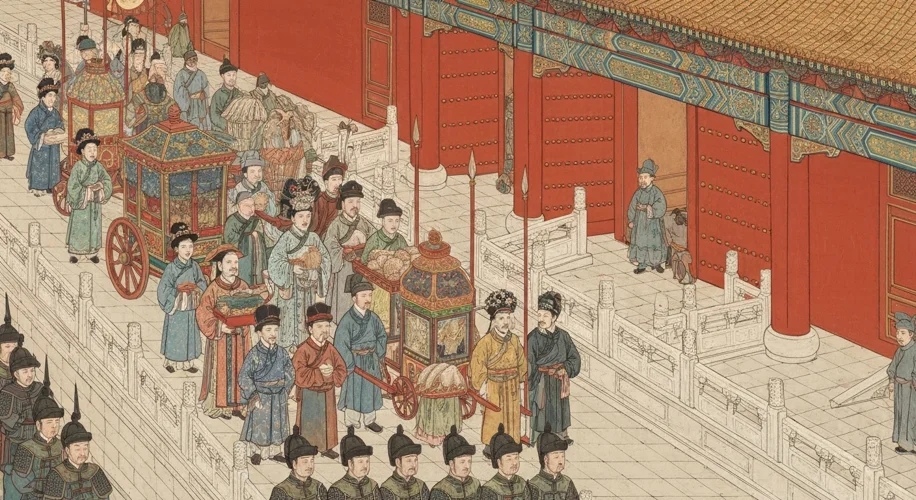Imagine a grand procession, a caravan laden with exotic goods winding its way towards the imperial palace. As the travelers approach, they are met not with suspicion or hostility, but with a calculated display of power and benevolence. This was the heart of the Chinese tributary system, a complex web of diplomatic, economic, and political relationships that shaped East Asia for centuries.
For millennia, China, under various dynasties, saw itself as the “Middle Kingdom” – the center of civilization. Surrounding it were what it perceived as “barbarian” lands, populated by peoples who, though perhaps unsophisticated, could be brought into the fold of Chinese influence. The tributary system was the primary tool for managing these relationships. It was a diplomatic ritual, a performance of submission that, in return, conferred legitimacy and often, material benefits.

The core of the system was the “tribute mission.” Envoys from foreign states would travel to the Chinese capital, bearing precious gifts – often local specialties like horses, furs, ivory, spices, or even rare metals. These gifts were not merely tokens of respect; they were a formalized acknowledgment of Chinese suzerainty. The emperor, in turn, would bestow his own “gifts” upon the envoys, which were almost always of greater value than the tribute they had offered. This practice was central to the system’s appeal and sustainability.
Consider the Kingdom of Joseon (Korea). For centuries, Joseon sent tribute missions to China. These missions were elaborate affairs, sometimes occurring annually. The Koreans brought goods like ginseng, paper, and silk. In return, they received Chinese silks, medicines, books, and, crucially, access to the lucrative Chinese market for their own products. The Chinese court also provided military protection and a degree of political legitimacy that bolstered the Joseon rulers’ authority at home and abroad.
This dynamic wasn’t always peaceful. The system could be strained by internal Chinese politics or by the ambitions of neighboring states. For instance, during the Ming Dynasty, the Jurchen tribes, who would later found the Qing Dynasty, were at times both tribute payers and military challengers. The system allowed for flexibility; states could be both subordinate and formidable, depending on the circumstances.
The economic aspect is particularly fascinating. While tribute missions were a performative display, they also facilitated trade. Tributary states were granted permission to trade with China during their missions. For a state like Ryukyu (modern Okinawa), which controlled vital sea lanes, this access to Chinese markets was a significant economic boon. They could import Chinese goods and re-export them, acting as middlemen in a regional trade network.
But was it truly a net gain for the tributary states? The question of whether they received more than they paid is complex and debated by historians. On the surface, the emperor’s “gifts” often exceeded the value of the tribute. However, the costs of sending these missions – the travel, the goods, the personnel – were substantial. Moreover, the tribute itself was often a selection of the best of their local products, representing a drain on their own resources.
Yet, the benefits were often intangible but significant. The legitimacy granted by the emperor was invaluable. It meant that other states, and often their own populations, were more likely to recognize their rulers. Access to Chinese technology, knowledge, and cultural prestige was also a considerable advantage. The system provided a framework for regional stability, reducing the likelihood of widespread conflict, as it offered a predictable and, for the most part, peaceful way to interact.

The tributary system was not static; it evolved over dynasties and changed in response to external pressures. The arrival of European powers in the 18th and 19th centuries, with their own models of international relations based on sovereign states and unequal treaties, began to erode the traditional tributary framework. China’s inability to effectively resist European encroachment ultimately led to the system’s decline.
In essence, the Chinese tributary system was a sophisticated diplomatic and economic tool that projected Chinese power and fostered regional integration for centuries. It was a performative act of submission, laden with symbolic meaning, but also a pragmatic arrangement that facilitated trade, offered security, and conferred legitimacy. While the true economic balance remains a subject of scholarly debate, the tributary system undeniably left an indelible mark on the political and cultural landscape of East Asia, proving that sometimes, the greatest gifts were not always material.

